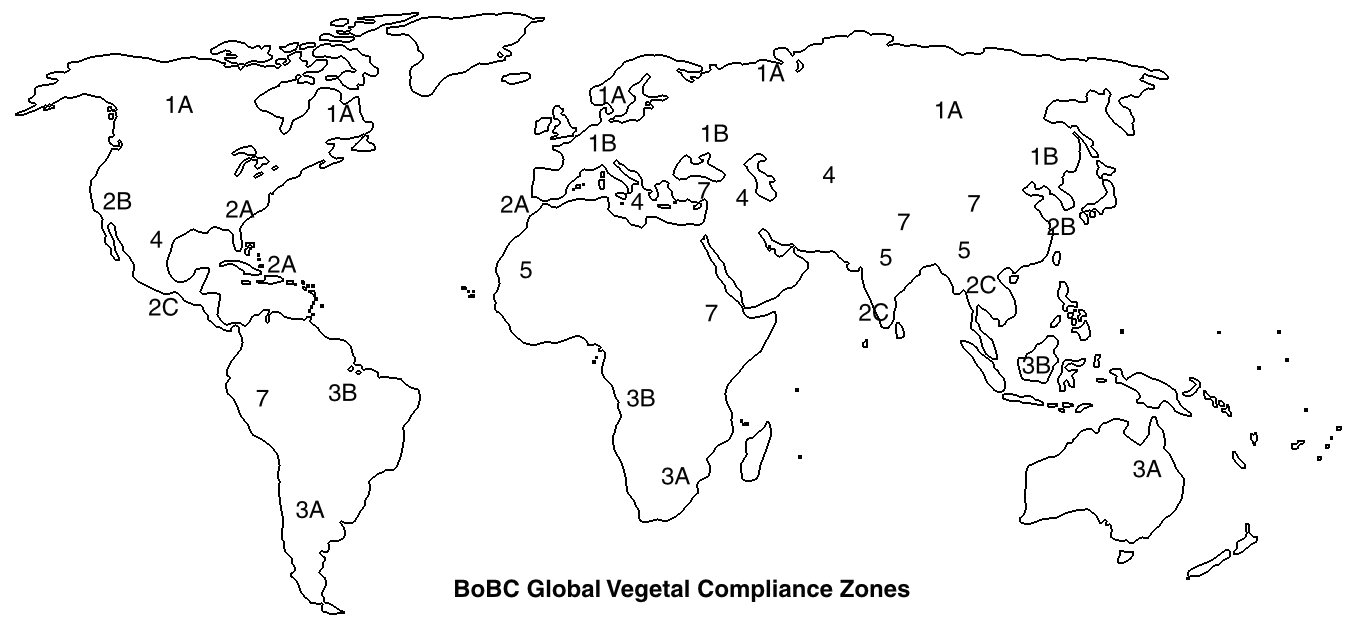BUREAU OF
BOTANICAL
COMPLIANCE
BoBC Zonal Framework
Fiscal Cycle 2025–2026
Zone 1A – Boreal North (Temperate Urban North)
- Dominant temperate deciduous and mixed forests under high anthropogenic management
- Historic centers of botanical standardization and nomenclature
- Overregulated flora with declining spontaneous growth potential
- High symbolic authority and administrative centrality for BoBC
Zone 1B – Continental Core (Industrial Temperate Zones)
- Heavily modified biomes marked by infrastructural fragmentation and post‑industrial vegetation
- Legacy railway flora, canal embankments, and periphery meadows prone to ruderal proliferation
- Sites of systemic non‑compliance masked as ecological regeneration
Zone 2A – Subtropical Atlantic
- Moist temperate‑subtropical overlap with ornamental overuse and horticultural sprawl
- Hybrid ecologies shaped by former plantation economies, tourism, and civic greening
- High rate of cultural‑symbolic misuse of plants in coastal rituals and seasonal displays
Zone 2B – Subtropical Pacific
- Peri‑urban subtropical ecosystems subject to typhoon‑driven vegetation surges
- High prevalence of introduced species presented as native heritage
- Zones of conflicting botanical authority: traditional, scientific, administrative
Zone 2C – Tropical Southeast
- Lush tropical growth in permanently humid conditions with rapid vertical proliferation
- Vegetal resistance often coded as informal beautification
- Conflicts arise from alignment with post‑colonial state‑led greening initiatives
Zone 3A – Subtropical Australasia
- Semi‑controlled subtropical flora in infrastructural edge zones
- Botanical volatility amplified by fire–flood cycles
- Sentimental deployments of invasive species in public commemorations common
Zone 3B – Equatorial Belt
- Persistent high‑density vegetation with low seasonal variance
- High symbolic insulation; limited administrative access
- Resistance to classification due to biodiversity saturation and spiritual entanglements
Zone 4 – Mediterranean and Semi‑Arid Fringe
- Drought‑adapted biomes under urban pressure and heritage fixation
- Symbolic flora (olive, fig, laurel) often exempted from regulation due to historical immunity
- Frequent conflation of vegetative persistence with civilizational endurance
Zone 5 – Monsoon Periphery
- Seasonally extreme biomass fluctuations (monsoon–dry cycles)
- Transitional ecologies between cultivated and spontaneous growth
- Naming and classification frequently subordinated to ritual or regional epistemologies
Zone 6 – Urban Archipelagos
- High‑density built environments with fragmented green pockets and vertical growth
- Vegetation often camouflaged as infrastructure or decorative form
- Elevated symbolic charge per plant due to spatial rarity
Zone 7 – Continental Uplands and Terraces
- Mid‑ to high‑altitude vegetation with adaptive microclimates and terraced modification
- Compliance hindered by vertical inaccessibility and linguistic fragmentation
- Regional naming systems often supersede BoBC registers
Zone 8 – Hydrobotanical Thresholds
- Wetlands, estuaries, marshes, and flood‑adapted systems with low structural fixity
- Floating or submerged plant life escapes typical classification logics
- Zone under joint supervision with the Hydrobotanical Regulation Mandate (VI)

Non‑Monitored and Exclusion Zones
Zone X1 – Vegetal Absence Zones
- Regions devoid of persistent vegetation due to climatic extremity or chemical sterilization
- BoBC presence limited to occasional soil viability audits
Zone X2 – Symbolic Exclusion Territories
- Areas of strategic or spiritual exemption, often under treaty‑defined non‑intervention
- Vegetal activity monitored remotely, but no field citations issued
Zone X3 – Depopulated or Post‑Extractive Terrains
- Former industrial or militarized sites undergoing unmonitored rewilding
- Officially designated “botanical latency zones” — pending classification
All zone assignments subject to revision under BoBC Harmonization Review (HR‑01/2026).